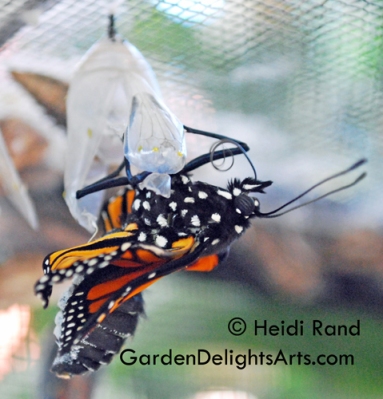For years, George and I have trekked to Albany Hill to count the monarch butterflies for the annual Western Monarch Thanksgiving Count, started by the Monarch Program in 1997. The largest clusters we’ve seen at Albany Hill arrived in 2011.

Monarchs wintering on Albany Hill in 2011, copyright Heidi Rand
Although numbers decreased for the past few years, early reports for 2015 from citizen spotters are markedly up. Most exciting locally is the discovery of a new clustering site in Berkeley’s Aquatic Park! The news quickly spread from hard-core monarch researchers to locals who had never seen the splendor of monarchs clustering, reported in an excellent article by Elaine Miller Bond on the Berkeleyside news site.
George and I rushed to see them yesterday. We had been told they were near the 14th basket of the disc-golf course, an easy walk from the Park’s north parking lot. Even without seeing many monarchs flying around in the clear winter sky, we couldn’t miss the spot where gawkers gathered beneath an ash tree with cameras and binoculars pointed up.

We estimated at least a thousand butterflies were clustering, and figured possibly double that many were flying around and would join the clusters for warmth and protection at sunset.

We watched for an hour as monarchs danced; leaving clusters to fly about and then return. Entranced, we marveled and shared information with people gathered there about planting milkweed, raising butterflies, and other local overwintering sites.

A closeup shows most of the cluster with wings closed, and one female (the male has two large spots near the veins at the bottom wing) with her wings open.

Have you seen any monarch butterflies in your garden or at an overwintering site? Do you grow milkweed or provide nectaring plants for butterflies and birds? For more information, and photos and stories about our adventures watching and raising monarch butterflies, see my prior blog posts:
Monarch Butterfly Mating Dance
A Monarch Butterfly Visits the Garden
Monarch caterpillar to chrysalis
First monarch caterpillar emerges
A Butterfly Born on the 4th of July


 And finally! Hundreds of gorgeous orange monarchs fluttered above us in the bright blue sky.
And finally! Hundreds of gorgeous orange monarchs fluttered above us in the bright blue sky.













 This is a closeup of him hanging onto the chrysalis that he emerged from.
This is a closeup of him hanging onto the chrysalis that he emerged from.  We let him rest overnight because the weather was cold and windy. Sunday brought a bit of sun, so we let him go.
We let him rest overnight because the weather was cold and windy. Sunday brought a bit of sun, so we let him go.
 She emerged the next day. Here’s a photo of her from the front.
She emerged the next day. Here’s a photo of her from the front. We raised and released three monarchs – two male and one female. Hopefully she’ll return to our garden to to lay more eggs, or if you’ve planted milkweed maybe she’ll find her way to your garden!
We raised and released three monarchs – two male and one female. Hopefully she’ll return to our garden to to lay more eggs, or if you’ve planted milkweed maybe she’ll find her way to your garden!









































